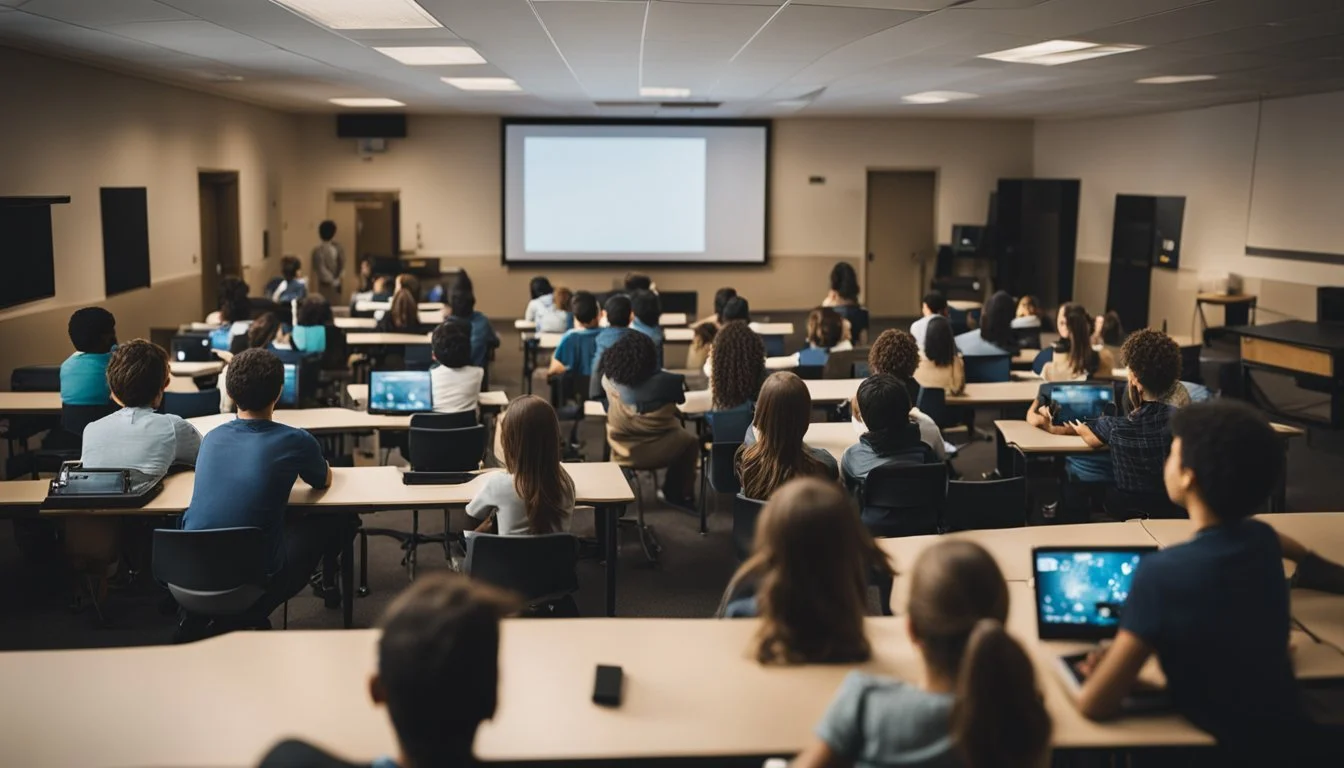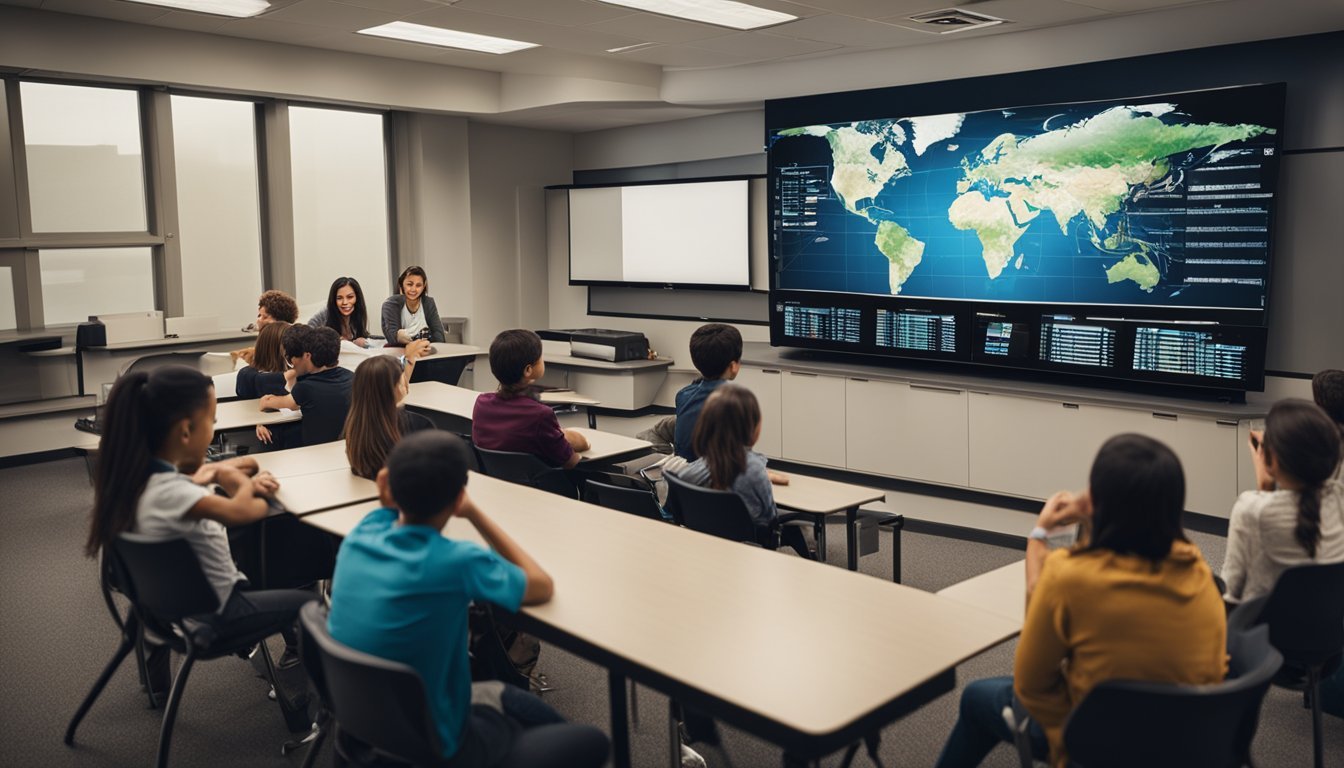Exploring the Boundaries of Film as an Educational Tool
Innovative Methods and Impact
The use of film as an educational tool has transformed the modern classroom, offering new ways to engage students and enrich their learning experiences. Films captivate students' attention through compelling storytelling and vivid imagery, making complex subjects more relatable and easier to understand.
Integrating films into curriculum not only stimulates students' critical thinking and analysis but also promotes cultural understanding and empathy. Students benefit from visual and emotional engagement, which often leads to deeper insights and lively discussions about the material.
By carefully selecting appropriate films, educators can address technical and content challenges and unlock the full potential of cinema in education. Exploring the boundaries of film in teaching opens up dynamic pathways for enriching the educational landscape.
Historical Evolution of Film in Education
Early films were used to deliver visual representations for better engagement. Over time, educational theories and advancing technology shaped their application in learning environments.
Early Uses of Film in Classrooms
The integration of film into classrooms began in the early 20th century. Educators used simple, silent films to illustrate scientific concepts and historical events. These films offered a new way of learning that differed from traditional textbooks. Thomas Edison and Kodak significantly contributed by producing educational reels.
By the 1930s, these films became more sophisticated, incorporating sound and narration. They were used to teach various subjects, including social studies and geography. Schools across the United States and Europe adopted this method, recognizing its effectiveness in engaging students.
Development of Educational Theories
The role of film in education evolved alongside pedagogical theories. Early assumptions suggested that visual media could significantly enhance learning retention. In the mid-20th century, scholars like Edgar Dale and Benjamin Bloom advanced these ideas. Dale's Cone of Experience listed motion pictures as highly effective for learning, second only to direct, hands-on experience.
Bloom’s Taxonomy further underscored the importance of multimedia in fostering higher-order thinking skills. These conceptual frameworks pushed educators to consider film not just as a supplementary tool, but as a core component in lesson planning. Researchers consistently found that films could cater to diverse learning styles, including visual and auditory learners.
Advancements in Film Technology
Technological advancements have continuously transformed the educational potential of films. With the advent of digital media, films became more accessible and easier to integrate into classrooms. Interactive features and online databases allowed teachers to curate customized content for their syllabi.
High-definition visuals and computer-generated imagery (CGI) enabled the creation of more engaging and realistic educational films. Streaming services and educational platforms like Khan Academy further democratized access to high-quality educational content. These innovations revolutionized how educators approached teaching, making film an indispensable tool in modern education.
Educational Film Genres
Educational films encompass diverse genres, each specialized in delivering knowledge and promoting understanding in distinct ways. They present information uniquely suited to their audiences, covering documentaries, instructional films, and public service announcements.
Documentaries
Documentaries offer in-depth analysis and real-world insights on various topics. They feature a narrative style coupled with real footage, interviews, and expert opinions. This genre is vital for presenting factual information, ranging from historical events to contemporary issues.
Additionally, documentaries often explore scientific phenomena or cultural practices, making complex subjects accessible. By portraying real-life scenarios, they engage viewers, fostering a deeper connection with the material. Examples include Ken Burns' "The Civil War" or David Attenborough's "Planet Earth."
Instructional Films
Instructional films are designed to teach specific skills or concepts. Often used in classrooms and training sessions, they provide step-by-step instructions and demonstrations. These films are instrumental in education for subjects like science, mathematics, and vocational training.
The format usually includes clear visuals and narration, making learning effective and engaging. Resources from organizations like Film Education support teachers in using these films to enhance their curriculum.
Also, by breaking down complex tasks into manageable steps, instructional films ensure learners achieve practical understanding and application of knowledge.
Public Service Announcements
Public Service Announcements (PSAs) are short films aimed at raising public awareness on important social issues. They convey messages on health, safety, and community welfare. PSAs are crucial in educating the public about topics like disease prevention, public safety, and environmental conservation.
Effective PSAs use compelling visuals and emotional appeals to prompt behavior change. Examples include campaigns against smoking or promoting seatbelt use, often run by governmental or nonprofit organizations. Notable PSAs like "This is Your Brain on Drugs" have had significant societal impact, influencing public attitudes and behaviors.
Cognitive Impact of Film on Learning
Films provide a powerful medium for enhancing learning by improving memory recall, fostering emotional engagement, and supporting different learning styles.
Memory Retention and Recall
Films can significantly enhance memory retention and recall. Visual storytelling combined with auditory elements creates a multi-sensory experience that aids in embedding information more deeply. The dual coding theory suggests that combining visual and verbal information can lead to better memory performance.
Studies indicate that students remember information presented in films more effectively compared to traditional text-based learning. This happens because films often present information in a context that makes it easier to recall. Additionally, repeating key points through dialogue and visual reinforcement helps solidify memory.
Emotional Engagement
Emotional engagement is another critical aspect where films excel. Engaging narratives and strong emotional content captivate the viewer’s attention and create a more immersive learning experience. Emotional involvement can enhance the motivation to learn and improve retention by making the material more relatable.
Films often evoke emotions that can help connect abstract concepts to real-life experiences. This connection can drive deeper understanding and long-term retention. Furthermore, the emotional journey experienced during the film can make learning more enjoyable and memorable.
Visual and Auditory Learning Styles
Films cater exceptionally well to both visual and auditory learners. For visual learners, films provide visual aids such as graphics, animations, and real-world footage that make abstract concepts easier to grasp. These visuals can simplify complex ideas by providing clear and concrete examples.
For auditory learners, dialogue, narration, and sound effects enhance comprehension and retention. Listening to information being spoken can help reinforce learning for those who benefit from auditory cues. By combining visual and auditory elements, films offer a holistic approach that can accommodate diverse learning preferences effectively.
Film as a Pedagogical Tool
Utilizing film in education offers innovative methods for engaging students and enhancing their intellectual and emotional growth. It provides a dynamic medium to integrate theoretical concepts with real-world examples.
Narrative Teaching Techniques
Film serves as a powerful narrative tool in education. By presenting stories and characters, it helps students relate to and understand complex ideas in a more engaging manner. Through narrative techniques, films can illustrate historical events, societal issues, and cultural differences, making abstract concepts more tangible. Students can explore different perspectives and empathize with various experiences, thereby deepening their comprehension.
Case Studies and Simulations
Films can be used to simulate real-life scenarios and case studies, providing a practical application of theoretical knowledge. This approach enables students to analyze and solve problems in a controlled, yet realistic environment. For instance, documentaries can present case studies on scientific discoveries or medical breakthroughs, allowing students to observe and critique the processes involved. These simulations enhance student engagement and foster collaborative learning.
Critical Thinking and Analysis
Film as a pedagogical tool significantly contributes to the development of critical thinking skills. By analyzing the plot, characters, and cinematic techniques, students learn to deconstruct and assess various elements of the film. This practice encourages them to question assumptions, evaluate evidence, and form reasoned arguments. Furthermore, discussions based on film content often stimulate deeper critical reflections on contemporary issues and ethical dilemmas, enriching the learning experience.
Integrating Film into Curriculum
Incorporating film into the curriculum enriches the learning experience by making lessons more engaging and relatable. This approach requires structured lesson plans, critical evaluation of content, and the integration of technology.
Lesson Planning with Film
Educators should begin by selecting films that align with curriculum goals. Historical films, for example, can bring significant events to life. Literary adaptations offer visual interpretations of texts. Documentaries can introduce complex concepts in science or social studies.
Identify learning objectives: Ensure the film supports specific educational goals.
Prepare discussion questions: Create questions that prompt students to think critically about the film’s content.
Supplement with activities: Design follow-up activities to reinforce the material covered in the film.
Evaluating Educational Content
Not every film is suitable for the classroom. Content must be vetted for educational value and appropriateness.
Relevance: Ensure the film directly relates to the lesson topic.
Age-appropriateness: Match the content to the maturity level of the students.
Accuracy: Confirm the accuracy of information provided in the film with verified sources.
These steps help in selecting films that enhance learning without causing distractions or misconceptions.
Technology Integration in the Classroom
Utilizing digital platforms and tools can optimize the use of film in education. Projectors and interactive whiteboards can enhance viewing experiences and facilitate discussions.
Streaming services: Platforms like Netflix and educational subscriptions provide access to a wide range of educational films.
Classroom management software: Tools like Google Classroom help in sharing and discussing film-based assignments.
Online discussions: Use forums and chat rooms to extend classroom discussions beyond viewing sessions.
By incorporating these technological advances, educators can create a seamless, interactive, and dynamic learning environment.
Challenges and Limitations
When using film as an educational tool, educators face various hurdles that can impact its effectiveness. These include cultural and linguistic barriers, budgetary constraints, and accessibility and inclusivity issues.
Cultural and Linguistic Barriers
Films often reflect the culture and language of their origin, which can present significant challenges in a diverse classroom. Students from different cultural backgrounds may find certain idioms, customs, or humor in films difficult to understand.
In addition, subtitles might not always be accurate, leading to potential misunderstandings. Educators must be aware of these issues and strive to select films that are culturally sensitive and inclusive. Choosing films that offer diverse perspectives can help mitigate these challenges, but it requires careful consideration and potentially additional resources to provide context.
Budgetary Constraints
The cost associated with acquiring and utilizing films in educational settings can be prohibitive. Licensing fees for screening films legally can be high, particularly for recent releases or popular titles.
Besides, the need for appropriate technology, such as projectors and sound systems, adds to the expense. Schools with limited financial resources might struggle to afford these costs, limiting their ability to integrate film effectively into the curriculum. Seeking funding through grants or other sources can alleviate some financial pressure, but it is often a time-consuming process with no guaranteed outcome.
Accessibility and Inclusivity Issues
Ensuring that all students have equal access to film-based materials is another critical challenge. Students with visual or hearing impairments may require specialized equipment or adaptations, such as audio descriptions or sign language interpretation.
Moreover, films need to be vetted for content that may be inappropriate or triggering for certain students. Creating an inclusive environment means considering these factors upfront and planning accordingly. Schools may need to offer alternative assignments or supplemental materials to ensure no student is left out of the learning experience provided by film.
Emerging Trends in Educational Filmmaking
Innovations in film technology have ushered in new methods for educational content delivery. From interactivity to virtual reality and collaborative content creation, educational films are becoming more engaging and effective.
Interactive and Immersive Experiences
Educational films now incorporate interactive elements to boost engagement and learning outcomes. Interactive videos allow viewers to make choices that affect the storyline, deepening their involvement and aiding in knowledge retention.
These experiences can feature quizzes, decision points, and branching narratives. For example, a history film might let students choose different paths based on significant historical decisions. This method not only makes learning active but also allows for customized educational experiences.
Utilization of Virtual Reality
Virtual Reality (VR) is revolutionizing educational films. VR provides fully immersive environments where learners can explore subjects in three dimensions. This is particularly valuable in fields like science and history, where traditional films may fall short in conveying complexity.
A VR film on human anatomy, for instance, can let students navigate through body systems, enhancing their understanding through direct interaction. The sensation of "being there" significantly enhances engagement and retention.
Crowdsourcing for Educational Content
Crowdsourcing democratizes the production of educational films by leveraging the collective expertise of a community. Platforms now enable teachers, students, and professionals to contribute to the creation process, ensuring diverse and comprehensive content.
Projects like these can also foster quicker production cycles and more relevant materials. For example, a mathematics documentary might feature contributions from educators worldwide, offering varied teaching perspectives and methodologies. This collaborative approach enriches the content's quality and scope.
Measuring the Effectiveness of Films in Education
Films have become a significant tool in educational environments. To evaluate their effectiveness, various criteria and metrics are used.
Engagement: Films can captivate student interest and maintain attention longer than traditional teaching methods. Surveys and feedback forms can quantify student engagement and satisfaction.
Learning Outcomes: Comparing test scores and assignments before and after film-based interventions helps in gauging improved understanding and retention of knowledge.
Empathy Development: Exposure to diverse perspectives through films enhances empathy among students. This can be assessed through reflective essays or discussions.
Active Participation: Films often encourage more interactive participation. Observing classroom dynamics and participation rates during film-related activities can provide useful insights.
Practical Applications: Using film clips to illustrate real-world scenarios helps in bridging theory with practice. This can be measured through applied projects or problem-solving tasks.
Example Metrics:
Criterion Method of Evaluation Engagement Surveys, Feedback Forms Learning Outcomes Pre- and Post-Test Comparisons Empathy Development Reflective Essays, Discussions Active Participation Observation, Participation Rates Practical Applications Applied Projects, Problem-Solving Tasks
These methods provide a structured approach to assess the impact of films in educational settings. Analyzing results helps educators refine their use of films to increase learning effectiveness.
Case Studies and Future Prospects
Exploring the boundaries of film as an educational tool requires a comprehensive look at successful implementations, emerging research opportunities, and predictions for its future use in education.
Successful Implementations
Various educational institutions have already seen success using film as an andragogical tool. In Africa, business schools have adopted films to develop ethical leadership among adult learners, integrating cinematic experiences with traditional teaching methods. These films serve as audio-visual case studies, accommodating diverse learning styles and enhancing engagement.
In Nigeria, films have been utilized to stimulate deep self-reflection among students. Educators advocate for the importance of reflection and provide structured guidance to maximize the educational impact of these films. This approach has led to improved critical thinking skills and better retention of complex concepts.
Research Opportunities
There are several areas where further research could expand the understanding and efficacy of film as an educational tool. One promising area is the investigation of how different genres or types of films impact various learning outcomes. Comparative studies can shed light on which specific elements of film—such as narrative structure, visual style, or thematic content—are most effective in educational settings.
Moreover, research could explore the longitudinal effects of film-based learning on students' academic performance and professional development. Investigating how film influences long-term retention of information and its applicability in real-world scenarios could provide valuable insights for educators.
Predictions for Film in Future Education
In the future, film is likely to become an increasingly integral part of both traditional and online educational platforms. Virtual reality (VR) and augmented reality (AR) technologies may enhance the cinematic experience, offering immersive learning environments that transcend the limitations of conventional classrooms.
With advancements in these technologies, films could be customized to suit individual learning needs, providing personalized educational experiences. Additionally, educators might leverage artificial intelligence (AI) to analyze student interactions with films, further tailoring the content to optimize learning outcomes.
Schools and universities will potentially integrate film-based curricula, recognizing its unique ability to blend entertainment with education, fostering a more engaging and effective learning experience.







